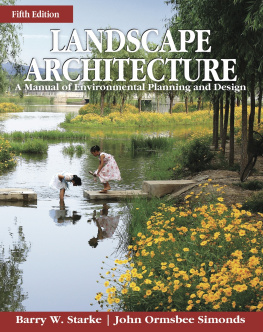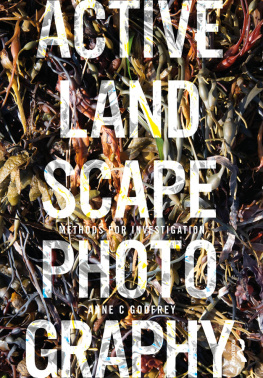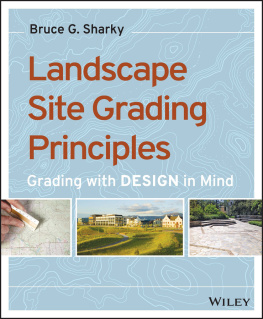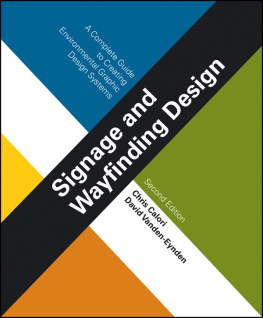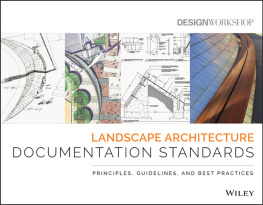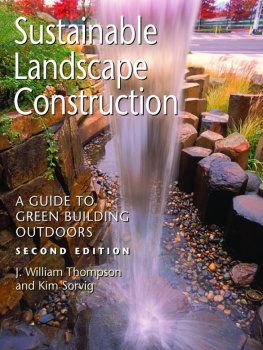Barry Starke - Landscape Architecture, Fifth Edition: A Manual of Environmental Planning and Design
Here you can read online Barry Starke - Landscape Architecture, Fifth Edition: A Manual of Environmental Planning and Design full text of the book (entire story) in english for free. Download pdf and epub, get meaning, cover and reviews about this ebook. year: 2013, publisher: McGraw-Hill Education, genre: Romance novel. Description of the work, (preface) as well as reviews are available. Best literature library LitArk.com created for fans of good reading and offers a wide selection of genres:
Romance novel
Science fiction
Adventure
Detective
Science
History
Home and family
Prose
Art
Politics
Computer
Non-fiction
Religion
Business
Children
Humor
Choose a favorite category and find really read worthwhile books. Enjoy immersion in the world of imagination, feel the emotions of the characters or learn something new for yourself, make an fascinating discovery.
- Book:Landscape Architecture, Fifth Edition: A Manual of Environmental Planning and Design
- Author:
- Publisher:McGraw-Hill Education
- Genre:
- Year:2013
- Rating:5 / 5
- Favourites:Add to favourites
- Your mark:
Landscape Architecture, Fifth Edition: A Manual of Environmental Planning and Design: summary, description and annotation
We offer to read an annotation, description, summary or preface (depends on what the author of the book "Landscape Architecture, Fifth Edition: A Manual of Environmental Planning and Design" wrote himself). If you haven't found the necessary information about the book — write in the comments, we will try to find it.
For more than 50 years, this pioneering guide has served as the foremost resource on the principles and practices of landscape architecture. Now, the book has been revised to address the latest developments in the field, providing a comprehensive, current presentation of the profession.
Richly illustrated with more than 400 full-color images, Landscape Architecture, Fifth Edition, explains how to plan and design for the human use of land with the least environmental impact. This updated volume offers new coverage of important topics such as sustainability, climate change, water conservation, land reuse, urban agriculture, stormwater management, low-impact design, and much more. This definitive reference:
- Introduces the fundamentals of site and environmental planning
- Describes the planning constraints imposed by the forms, forces, and features of nature and our built environment
- Addresses climate and its design implications
- Discusses site selection and analysis
- Instructs in the planning of workable and well-related use areas
- Describes the volumetric shaping of exterior spaces
- Explores site-structure relationships and organization
- Applies contemporary thinking in the planning of expressive human habitations and communities
Landscape Architecture, Fifth Edition, preserves the essential character and timelessness of the original classic while incorporating up-to-date advancements in the profession.
Extensively revised and filled with more than 400 contemporary full-color images, Landscape Architecture, Fifth Edition, remains the quintessential resource on planning for the human use of land in harmony with the environment. The book presents a systematic approach to the creation of more usable, efficient, and attractive outdoor spaces and places. Teaching diagrams, plans, photographs, and graphics--including the works of many of the worlds leading landscape architects and firms--are featured throughout. This thoroughly modernized classic offers new coverage of:
- Sustainability
- Climate change and global warming
- Water preservation and water rights
- Land reuse and brownfield redevelopment
- GIS mapping
- Invasive species
- Urban agriculture and urban forestry
- Stormwater management
- Low-impact design
- Complete streets
- New Urbanism, Smart Growth, and Traditional Neighborhood Development
Landscape Architecture, Fifth Edition, addresses every aspect of site and environmental planning, design, and implementation, including:
- The most comprehensive, current guide to the theory and practice of landscape architecture
- The human habitat and sustainability
- Climate
- Water
- Land
- Vegetation
- The visual landscape
- Topography
- Community planning and growth management
- Rational land use planning
- Urban design
- Site planning
- Site spaces
- Circulation
- Structures
- Landscape planting
Barry Starke: author's other books
Who wrote Landscape Architecture, Fifth Edition: A Manual of Environmental Planning and Design? Find out the surname, the name of the author of the book and a list of all author's works by series.

